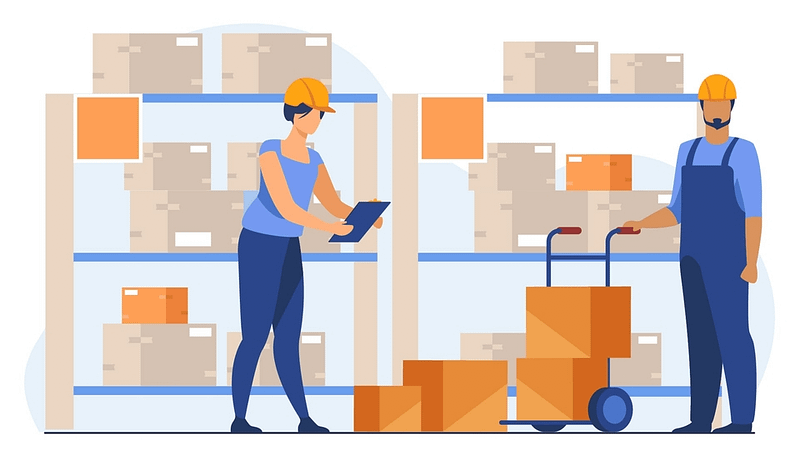Per ogni azienda la gestione del magazzino è un’attività centrale e vanno organizzati correttamente tutti gli aspetti che lo riguardano.
Perciò è fondamentale dotarsi degli strumenti adatti che permettono di monitorare il trasporto, la ricezione, gli acquisti, le scorte, lo stoccaggio e la distribuzione
In questo articolo vediamo le tematiche più importanti legate alla gestione del magazzino: cosa significa, quali sono le attività principali, quali i fattori da tenere in considerazione (personale, sicurezza, documentazione, logistica).
Vediamo anche come un software rende efficienti e automatiche tutte le operazioni aiutando a migliorare e incrementare il funzionamento e la produttività aziendale.
Cosa significa gestire il magazzino
La gestione del magazzino comprende diverse operazioni: il ricevimento merci, l’organizzazione dello spazio di magazzino, la pianificazione del lavoro, la gestione delle scorte e dell’inventario, l’evasione degli ordini.
La gestione del magazzino include diversi processi che vanno integrati e ottimizzati per gestire in modo efficace e veloce l’intero flusso delle merci. Comprende infatti:
- Gestione dell’inventario: il processo di verifica fisica di tutti i materiali effettivamente presenti a magazzino: materie prime, semilavorati, prodotti finiti. La giacenza fisica rilevata va confrontata con quella registrata nel sistema gestionale: così si possono individuare differenze, prodotti deteriorati, rotti o mancanti.
- Gestione delle scorte: si riferisce allo stock di articoli (prodotti finiti) presenti a magazzino, pronti per la vendita o la distribuzione.
- Logistica di magazzino: si occupa di organizzare l’intera catena di approvvigionamento, produzione e distribuzione. Obiettivo è ottimizzare la movimentazione delle merci in modo efficiente e al minor costo.
Le 7 attività principali della gestione del magazzino
Per aziende della produzione industriale e del commercio gestire il magazzino è fondamentale.
Una corretta gestione richiede diverse operazioni e attività: vediamo quali sono le principali.
- Progetti e piani di logistica. Un apposito progetto tecnico e operativo permette di gestire tutti i beni presenti nel magazzino disponendoli secondo logiche che ne permettono il recupero in modo facile e veloce.
- Ordini di acquisto e rapporti con i fornitori. Se vuoi gestire in modo efficiente il tuo magazzino devi gestire ordini in arrivo, controllo delle scadenze, piani di riordino, tenendo sotto controllo la movimentazione dei prodotti dai fornitori alla tua azienda ai tuoi clienti.
- Ricevimento, registrazione e controllo dei beni. È fondamentale tenere traccia in tempo reale del flusso di beni in entrata e in uscita.
- Picking, imballaggio e confezionamento. Il picking è l’operazione di prelievo di colli e prodotti. Questi devono poi essere imballati e/o confezionati in modalità adeguata a seconda della spedizione.
- Conservazione e stoccaggio. Tutti i beni, i colli e i prodotti devono essere custoditi e conservati in un ambiente idoneo secondo quanto prescritto dalle normative di settore.
- Inventari, statistiche, contabilità. L’inventario di magazzino deve essere sempre aggiornato e disponibile tramite report in tempo reale. Così potrai avere il pieno controllo su tutte le attività e potrai gestire nel modo migliore la contabilità.
- Consegna e distribuzione. La consegna e distribuzione dei beni o delle merci stoccate nel magazzino deve avvenire in modo efficiente e veloce.
4 fattori da tenere in considerazione nella gestione del magazzino
Fondamentale è avere una corretta organizzazione: vediamo quali sono i fattori essenziali da tenere in considerazione nella gestione del magazzino.
1. Personale
Per la perfetta gestione di un magazzino è fondamentale il personale.
Gli operatori dovrebbero essere divisi su vari livelli in modo che ci sia una gerarchia decisionale e che tutti sappiano esattamente qual è il proprio compito, nel rispetto della sicurezza aziendale.
È fondamentale inoltre parlare con lo staff della logistica, dello smistamento, dell’ordine e del software e conoscere le loro necessità e osservazioni, così da rettificare eventuali problematiche e migliorare il funzionamento logistico.
2. Sicurezza
La sicurezza è un fattore primario e non va sottovalutata.
Il magazzino va tenuto in sicurezza adeguando l’ambiente di lavoro alle prescrizioni normative (nazionali ed europee), affidandosi alla consulenza di tecnici qualificati.
Ogni macchinario o attrezzo deve essere collocato secondo criteri prestabiliti, senza intralciare le uscite di emergenza o rischiare di cadere sugli operai. Fondamentali sono i controlli periodici e le revisioni.
I regolamenti di sicurezza devono essere esposti e sempre visibili. Ben visibile e fruibili devono essere anche dispositivi come cassette o armadietti di pronto soccorso, defibrillatori, estintori, allarmi.
Gli addetti al magazzino devono:
- Essere adeguatamente formati sulle procedure di sicurezza a norma di legge.
- Frequentare specifici corsi sull’utilizzo sicuro dei dispositivi e dei mezzi di trasporto e movimentazione merci.
- Aver ricevuto almeno una formazione di base in merito a pratiche di pronto soccorso e antincendio.
3. Documentazione
La documentazione è fondamentale: permette di rispondere a tutti gli accertamenti e di ottenere informazioni per migliorare la gestione del magazzino.
I documenti necessari alla gestione del magazzino sono:
- Documento di trasporto o DDT: il documento accompagnatorio e obbligatorio per legge per il trasporto delle merci. Deve riportare una serie di dati specifici, tra cui:
- il numero progressivo;
- la data di consegna;
- le generalità dei soggetti coinvolti e quelle di eventuali soggetti terzi coinvolti nel trasporto;
- la natura, la qualità e la quantità dei beni oggetto del trasporto.
- Fatture di acquisto e vendita: necessarie per gli adempimenti fiscali e per tutti i conteggi e le operazioni di carico e scarico dei prodotti a magazzino.
- Inventario: la lista di tutti i prodotti in magazzino e del loro valore, fondamentale per monitorare la situazione delle scorte.
- Distinta base di produzione: la lista dei materiali e dei componenti necessari alla realizzazione di un determinato prodotto, utilizzata in fase di progettazione, produzione e assemblaggio del prodotto finito e pronto per essere commercializzato e per gestire gli approvvigionamenti evitando eccessi di giacenze in magazzino.
4. Logistica
La logistica controlla l’ingresso e l’uscita delle merci. L’aspetto più importante dell’organizzazione di un magazzino è infatti riuscire a trovare in modo veloce ed efficace l’articolo che si sta cercando evitando di rallentare l’intera catena di spedizione.
L’organizzazione della logistica può seguire diversi criteri, tra cui:
- Collocamento in zone diverse per i prodotti venduti, materiali forniti, resi;
- Esposizione sugli scaffali in base a data di scadenza, forma e colore, occasione d’uso, ordine alfabetico, tipologia di materiale.
Essenziale è indicare in modo chiaro e preciso sull’etichetta le informazioni chiave per la preparazione del pacco e la sua consegna.
Per far funzionare correttamente un magazzino è opportuno che ogni fase sia digitalizzata e tracciabile, soprattutto se la mole di lavoro è elevata e/o in aumento.
Gestire correttamente il magazzino con l'uso di un software adeguato
Per poter gestire il magazzino in maniera efficiente è necessario utilizzare strumenti adeguati.
Molte attività, soprattutto di piccole dimensioni, si affidano a Excel o analoghi programmi di fogli di calcolo che posseggono template dedicati al magazzino. L’uso di questi programmi, però, comporta diversi rischi:
- Perdita di informazioni importanti a causa di salvataggi scorretti, cancellazioni accidentali, guasti tecnologici.
- Inserimento di informazioni sbagliate e non aggiornate in tempo reale, con la conseguenza di dover fare costantemente controlli e revisioni;
- Aggregazione manuale dei dati difficoltosa e report poco curati.
Perché usare un software di gestione del magazzino?
La soluzione più sicura e affidabile è dotarsi di un software di gestione di magazzino.
Il software infatti garantisce maggiore controllo e protezione dei dati e assicura vantaggi, tra cui:
- La costante tracciabilità delle merci;
- Accesso a tutti i dati aggiornati in tempo reale;
- Report e statistiche corrette e automatiche grazie all’aggregazione dei dati;
- L’uso di dati incrociati per ottimizzare la strategia di vendita;
- Il monitoraggio di scorte e riordini.
Le funzionalità principali del software
Un software di gestione del magazzino può avere varie funzioni. Le principali sono:
- Reorder point (punto di riordino): corrisponde alla soglia minima di un prodotto. Il software dunque informa quando un determinato prodotto va riordinato.
- Asset tracking (controllo dei beni): permette di tracciare il prodotto in magazzino tramite codice a barre o un altro criterio come il numero di serie.
- Product identification (identificazione del prodotto): aiuta a identificare il prodotto, ricostruendo la sua storia e i suoi spostamenti.
- Inventory optimization (ottimizzazione dell’inventario): permette di impostare vari fattori – come il punto riordino, la quantità del prossimo ordine, la velocità della produzione – per ottimizzare e automatizzare il lavoro di gestione del magazzino e dell’inventario.
Le soluzione software per la gestione del magazzino proposte da DueEsseTi
DueEsseTi ha una lunga esperienza nel settore del commercio e della distribuzione e propone due differenti soluzioni software per la gestione del magazzino: l’ERP all in one Odoo, dic ui siamo partner, e IMGZ, una soluzione verticale da noi sviluppata.
Tramite il software all in one Odoo puoi coprire tutte le necessità della tua azienda, compresa la gestione del magazzino.
Le sue funzionalità consentono di:
- Avere sempre una stima aggiornata delle scorte;
- Controllare tutti i movimenti di carico e scarico;
- Gestire magazzini multipli;
- Creare un inventario per zona, prodotto specifico, lotto di bancali/scatole;
- Tracciare tutte le operazioni (riti, ordini di consegna, controllo qualità).
Con Odoo potrai quindi gestire in modo efficiente il magazzino e migliorare le prestazioni dell’intera azienda.
Noi di DueEsseTi combiniamo le sue funzionalità con le nostre competenze informatiche: adattiamo il software alle tue esigenze.
iMGZ è il software di gestione magazzino sviluppato da DueEsseTi, progettato per ottimizzare la gestione delle scorte, il controllo degli ingressi e delle uscite e l’intero flusso di lavoro del magazzino.
Questa soluzione all’avanguardia permette di automatizzare i processi, aumentare la precisione del tracciamento dell’inventario e migliorare l’efficienza operativa, garantendo al contempo una riduzione degli errori e dei costi di gestione.
È la soluzione perfetta per le aziende che desiderano modernizzare e rendere più efficienti le proprie operazioni di magazzino.
Gestisci il tuo magazzino in modo efficiente
Contattaci per spiegarci le tue esigenze. Ti presenteremo le nostre soluzioni software e ti forniremo una demo gratuita.



